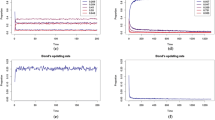Abstract
This paper presents our first version of Protein modeling Cellular Automata Machine (PCAM). The peptide chain of amino acid backbone of a protein having n number of amino acids is designed with an 8n cell uniform CA employing one of the 64 three neighborhood CA (3NCA) rules. Each amino acid of a protein chain is modeled by a group of eight CA cells. Variation of the interaction pattern of a protein backbone under different physical conditions is modeled with different sixty-four 3NCA rules. Another set of twenty 8-bit patterns are next designed to encode the molecular structure of side chains of twenty amino acids. The eight CA cells representing an amino acid in the chain is initialized with the 8 bit pattern of its side-chain. A set of features extracted from evolution of PCAM are mapped to real life experimental results. The PCAM model is validated from cancer immunotherapy experimental results for MAb-PD-L1 interaction on multiple MAbs (Monoclonal Antibodies) with the protein PD-L1 associated in human immunity.
Access this chapter
Tax calculation will be finalised at checkout
Purchases are for personal use only
Similar content being viewed by others
References
Min, S., Lee, B., Yoon, S.: Deep learning in bioinformatics. Brief. Bioinform. 18(5), 851–869 (2017)
Libbrecht, M.W., Noble, W.S.: Machine learning applications in genetics and genomics. Nat. Rev. Genet. 16(6), 321 (2015)
Moreira, I.S., et al.: SpotOn: high accuracy identification of protein-protein interface hot-spots. Sci. Rep. 7(1), 8007 (2017)
Burks, C., Farmer, D.: Towards modeling DNA sequences as automata. Physica 10D 10(1–2), 157–167 (1984)
Sirakoulis, G., Karafyllidis, I., Mizas, C., Mardiris, V., Thanailakis, A., Tsalides, P.: A cellular automaton model for the study of DNA sequence evolution. Comput. Biol. Med. 33(5), 439–453 (2003)
Xiao, X., Shao, S., Ding, Y., Chen, X.: Digital coding for amino acid based on cellular automata. In: 2004 IEEE International Conference on Systems, Man and Cybernetics, vol. 5, pp. 4593–4598, October 2004
Xiao, X., Wang, P., Chou, K.-C.: Cellular automata and its applications in protein bioinformatics. Curr. Protein Pept. Sci. 12(6), 508–519 (2011)
Cristea, P.: Independent component analysis for genetic signals. In: SPIE Conference BIOS 2001-International Biomedical Optics Symposium, San Jose, pp. 20–26, January 2001
Pan, Y.-X., et al.: Application of pseudo amino acid composition for predicting protein subcellular location: stochastic signal processing approach. J. Protein Chem. 22(4), 395–402 (2003)
Ghosh, S., et al.: On invertible three neighborhood null-boundary uniform cellular automata. Complex Syst. 20(1), 47 (2011)
Haralick, R.M., Shanmugam, K.: Textural features for image classification. IEEE Trans. Syst. Man, Cybern. 3(6), 610–621 (1973)
De Maesschalck, R., Jouan-Rimbaud, D., Massart, D.L.: The mahalanobis distance. Chemom. Intell. Lab. Syst. 50(1), 1–18 (2000)
Tan, S., Zhang, C.W.H., Gao, G.F.: Seeing is believing: anti-PD-1/PD-L1 monoclonal antibodies in action for checkpoint blockade tumor immunotherapy. Sig. Transduct. Target. Ther. 1, 16029 (2016)
Zhang, F., et al.: Structural basis of the therapeutic anti-PD-L1 antibody atezolizumab. Oncotarget 8(52), 90215–90224 (2017). PMC.Web. 12 March 2018
Tan, S., et al.: Distinct PD-L1 binding characteristics of therapeutic monoclonal antibody durvalumab. Protein Cell 9(1), 135–139 (2018)
Wishart, D.S., et al.: DrugBank 5.0: a major update to the DrugBank database for 2018. Nucleic Acids Res. 46(D1), D1074–D1082 (2017)
Author information
Authors and Affiliations
Corresponding author
Editor information
Editors and Affiliations
Rights and permissions
Copyright information
© 2018 Springer Nature Switzerland AG
About this paper
Cite this paper
Ghosh, S., Chaudhuri, P.P. (2018). Cellular Automata Model for Proteomics and Its Application in Cancer Immunotherapy. In: Mauri, G., El Yacoubi, S., Dennunzio, A., Nishinari, K., Manzoni, L. (eds) Cellular Automata. ACRI 2018. Lecture Notes in Computer Science(), vol 11115. Springer, Cham. https://doi.org/10.1007/978-3-319-99813-8_1
Download citation
DOI: https://doi.org/10.1007/978-3-319-99813-8_1
Published:
Publisher Name: Springer, Cham
Print ISBN: 978-3-319-99812-1
Online ISBN: 978-3-319-99813-8
eBook Packages: Computer ScienceComputer Science (R0)




